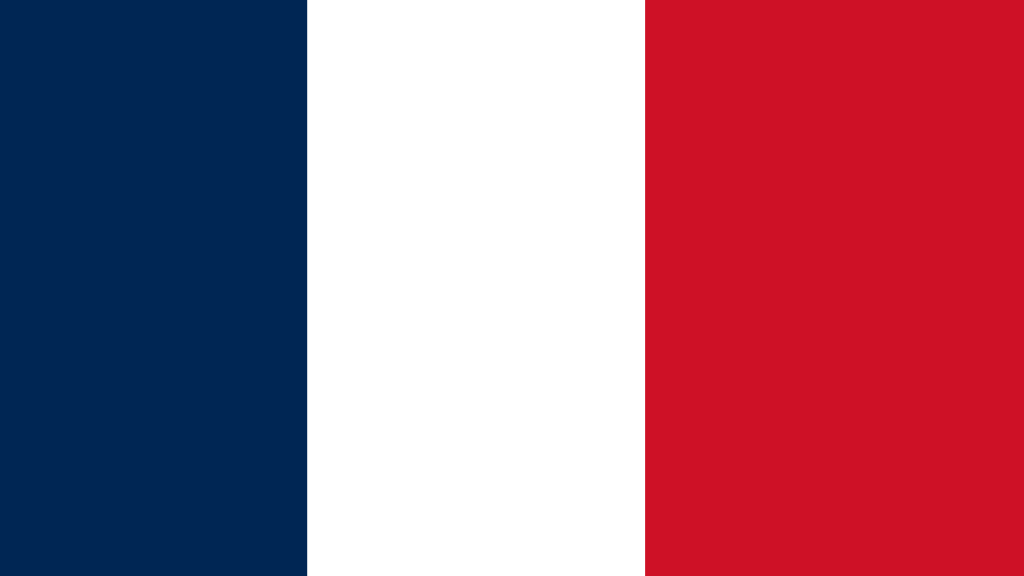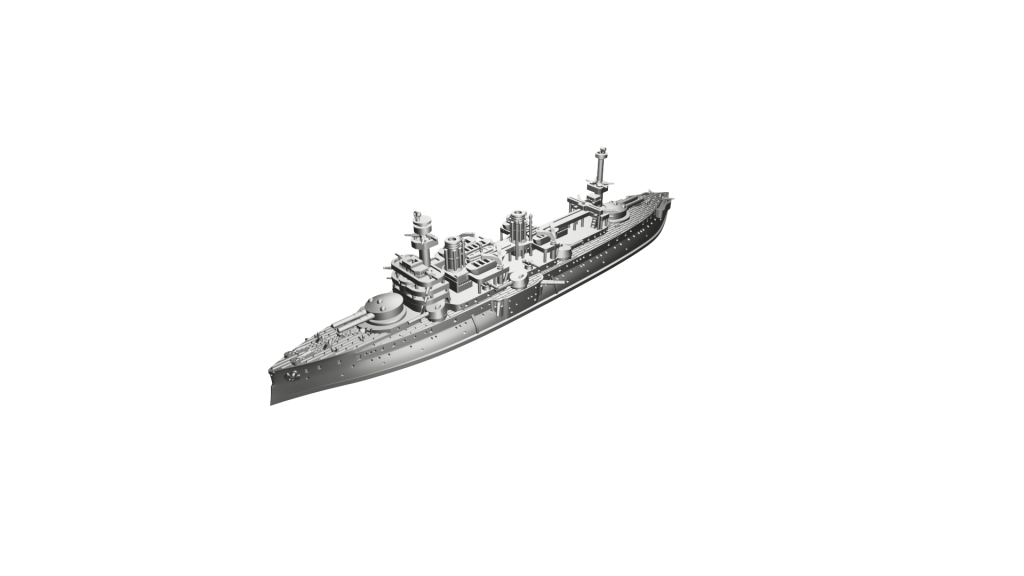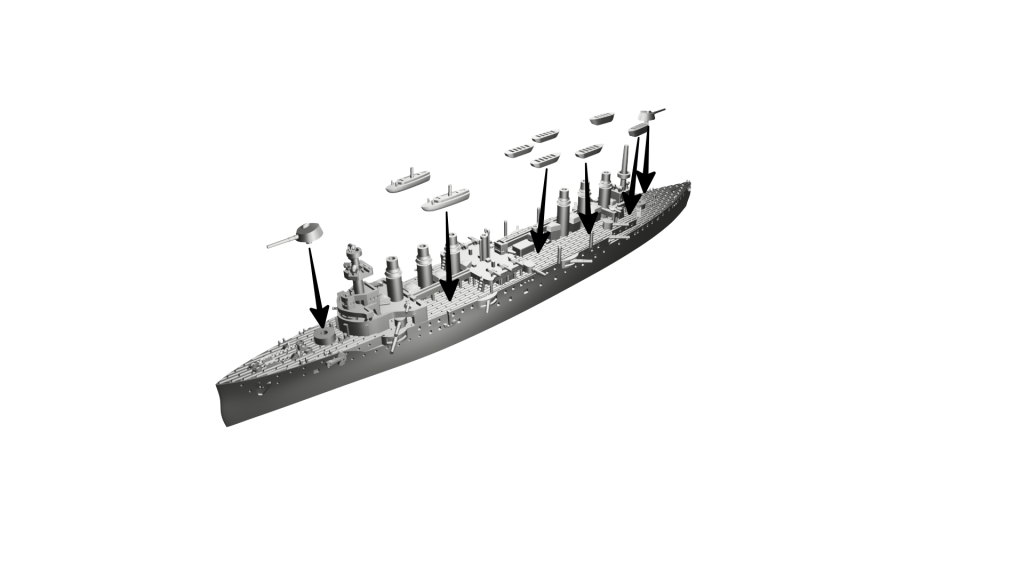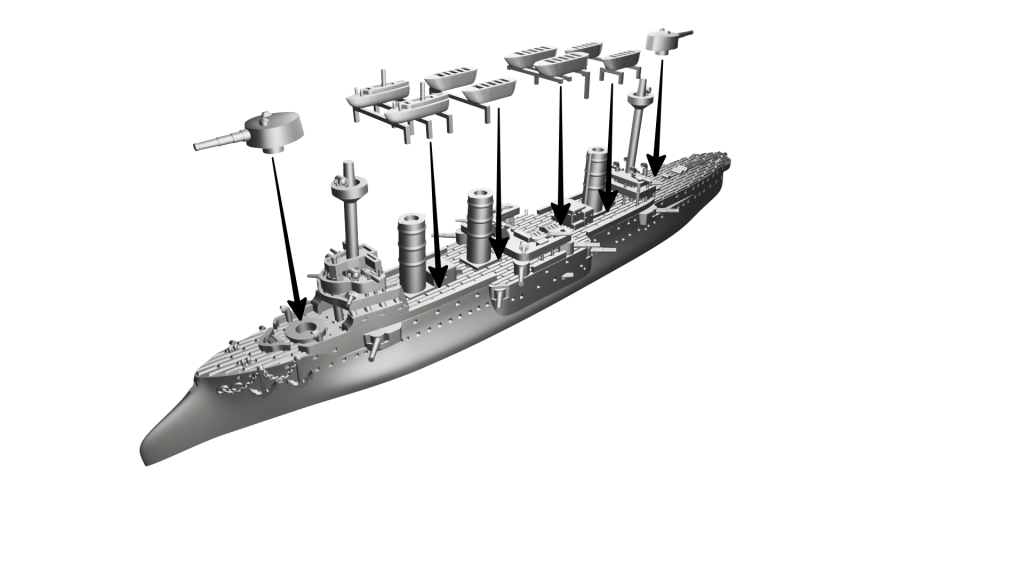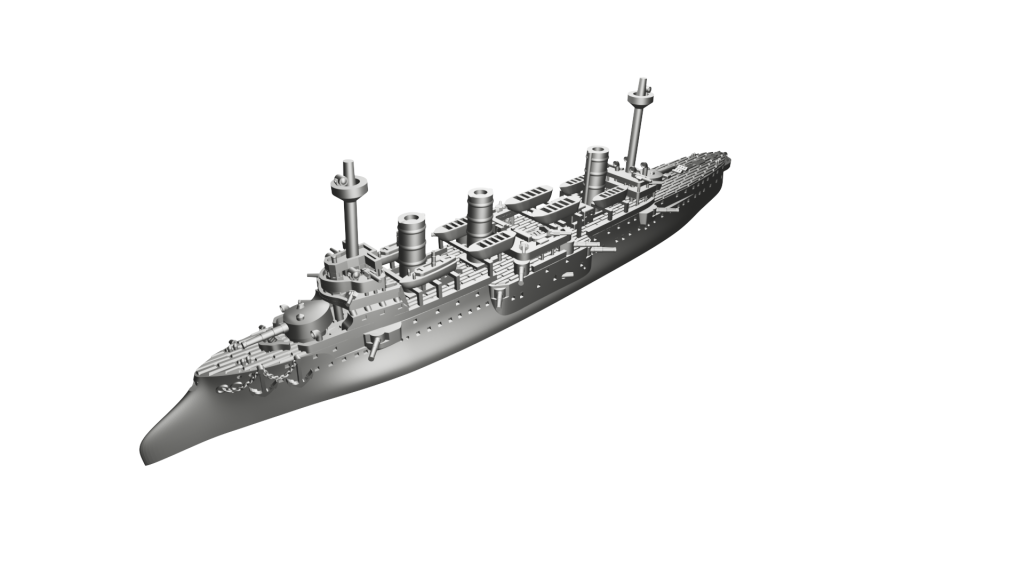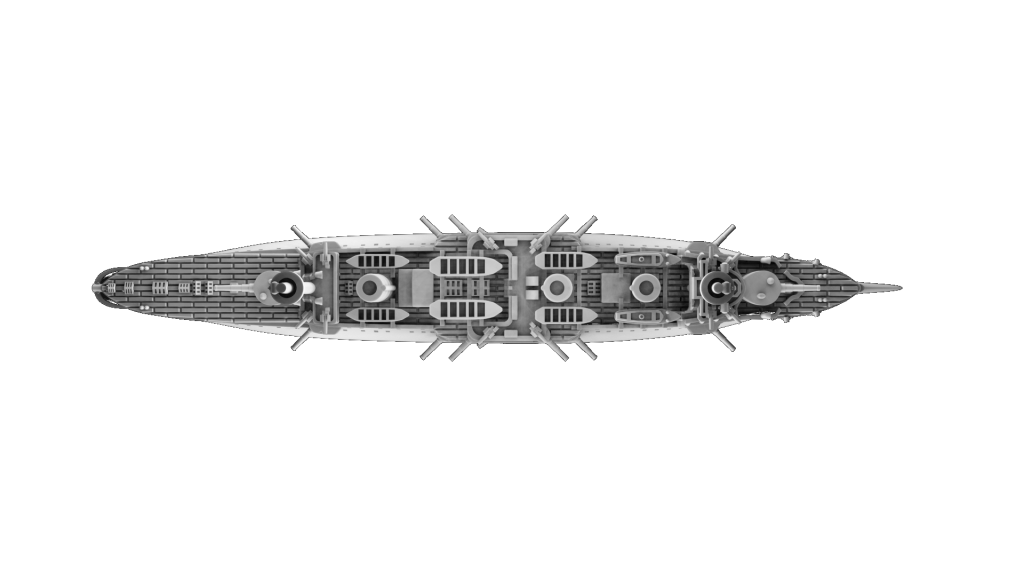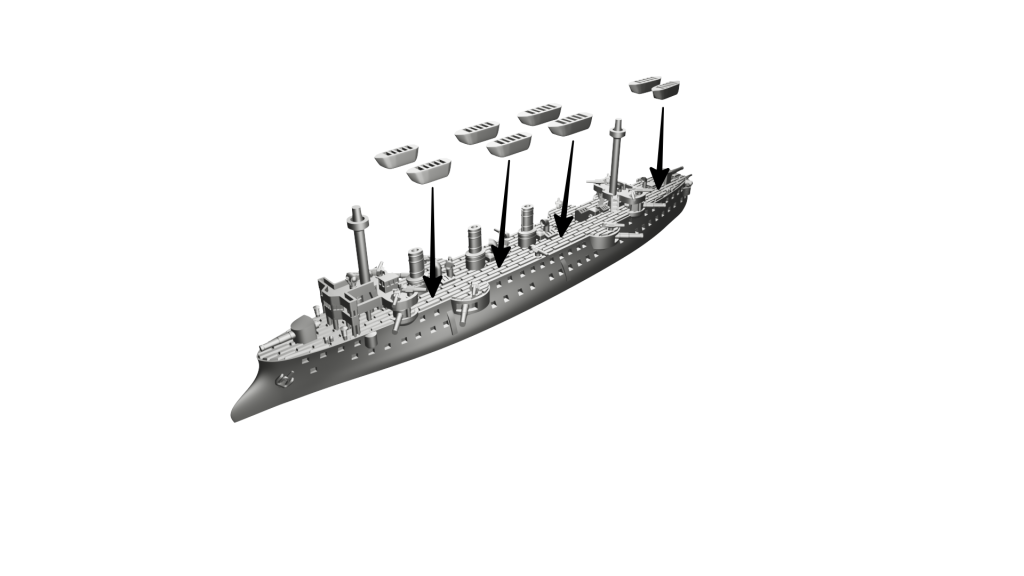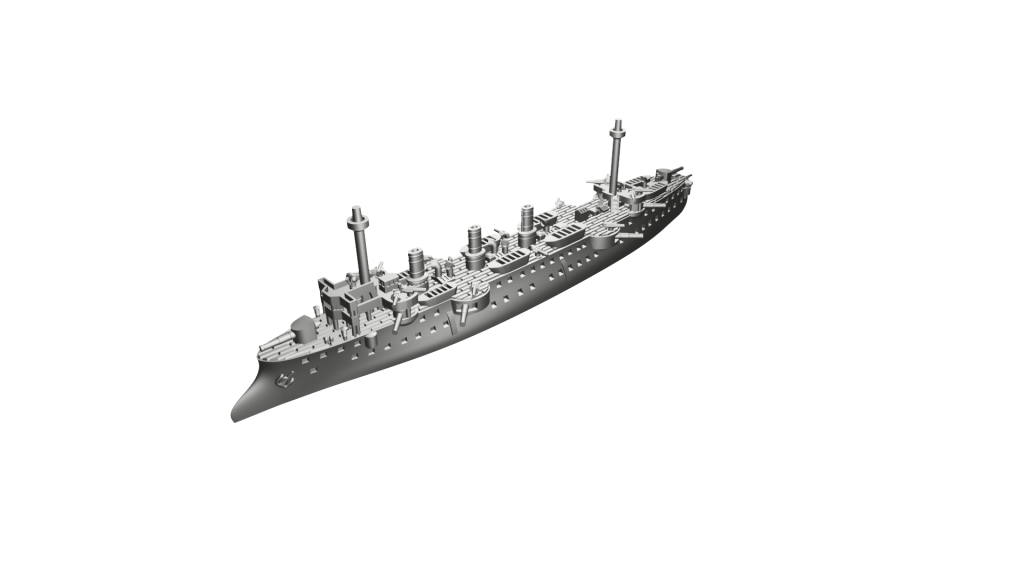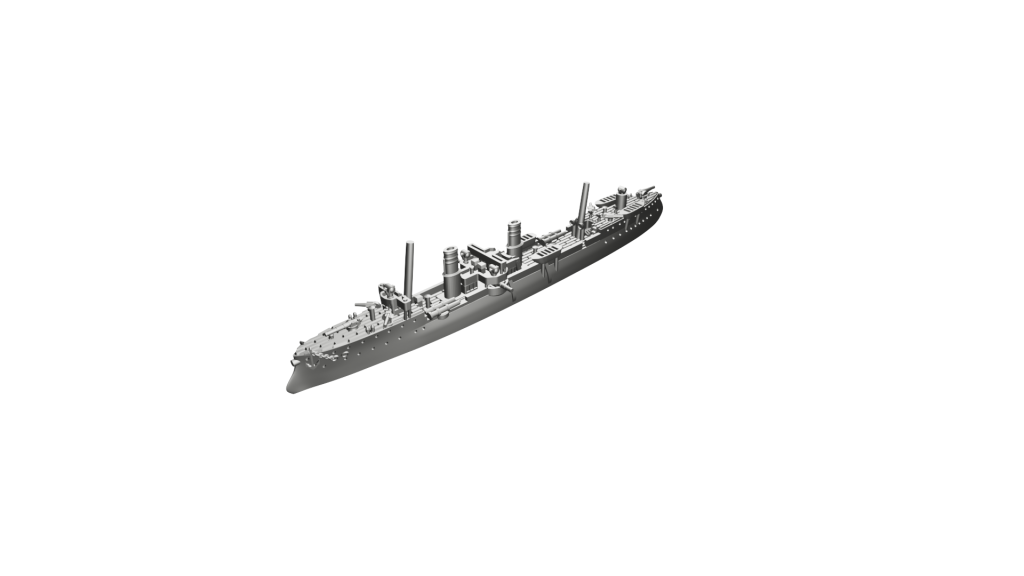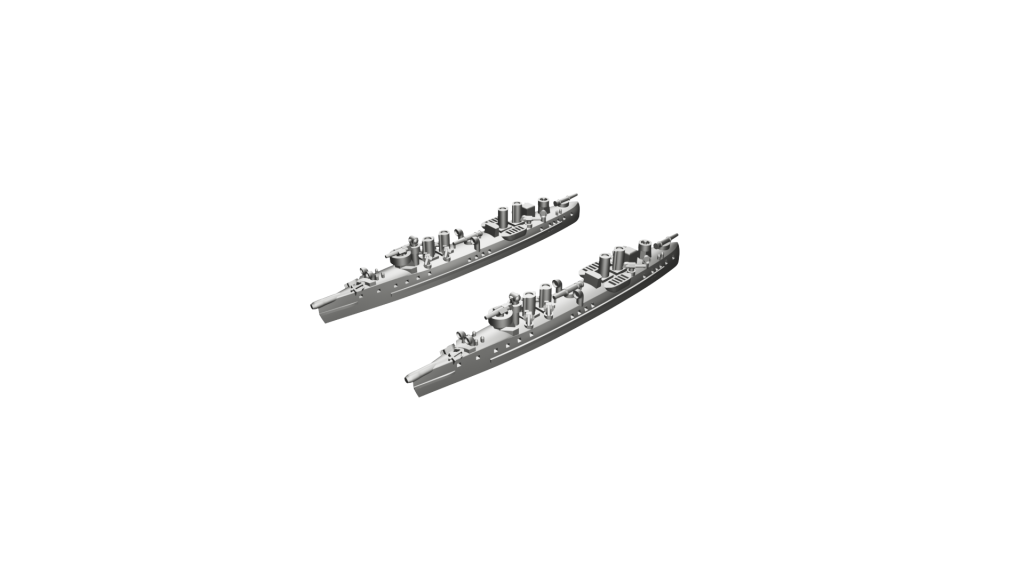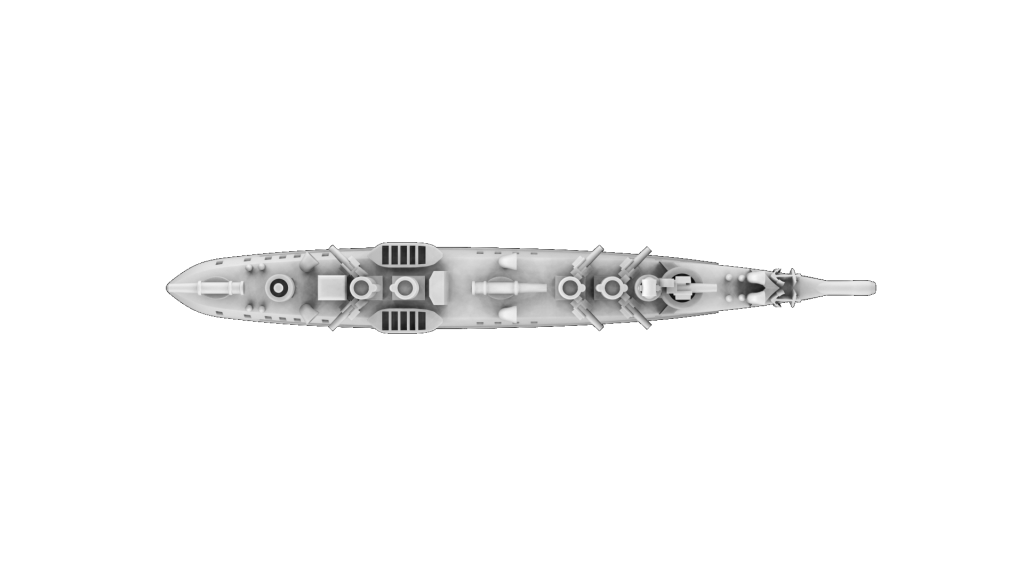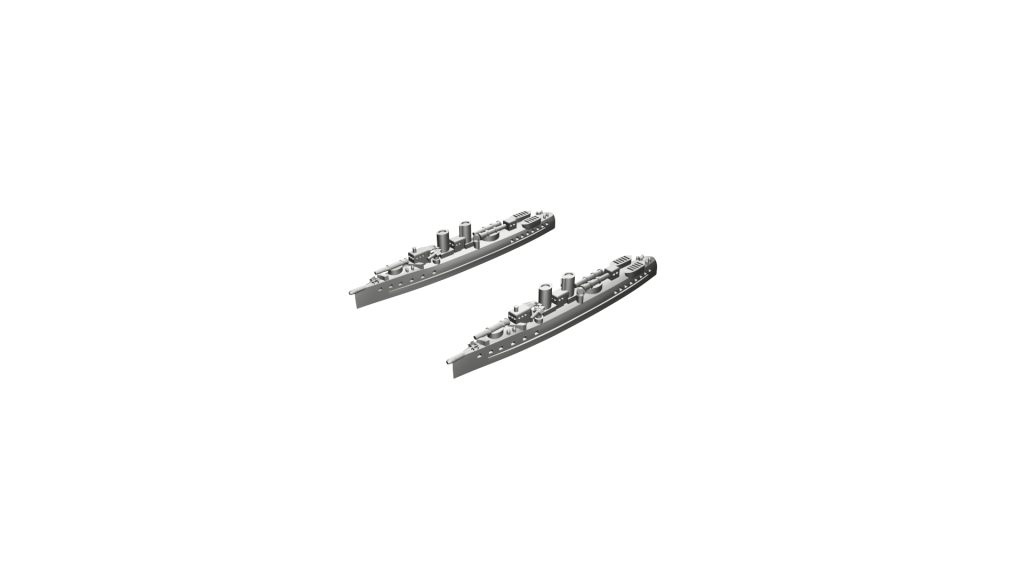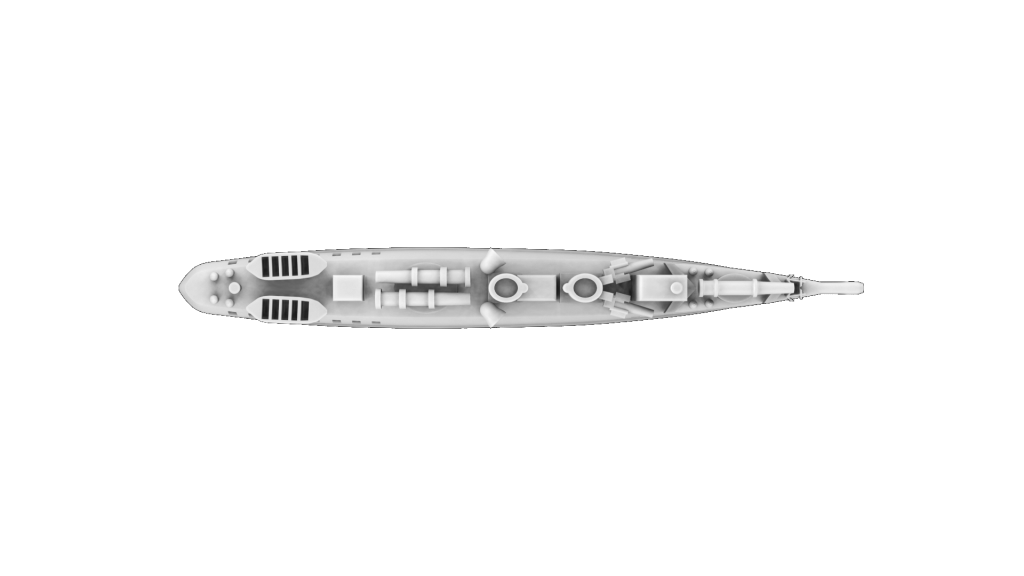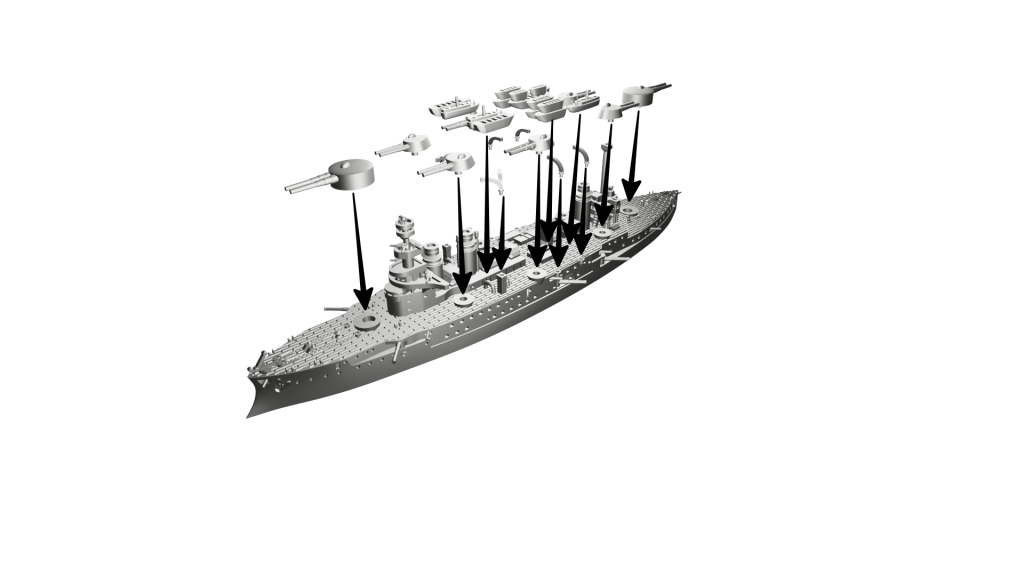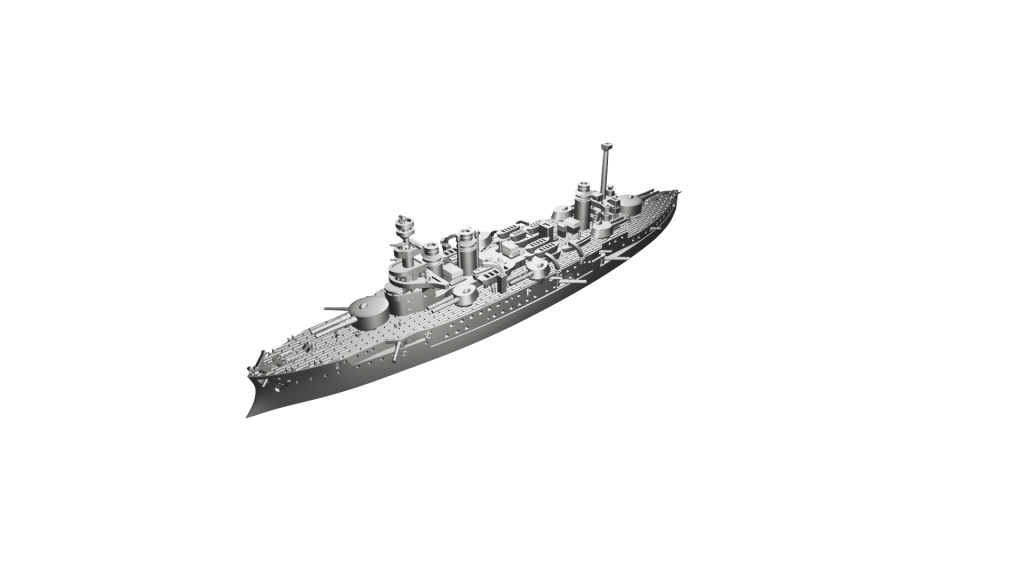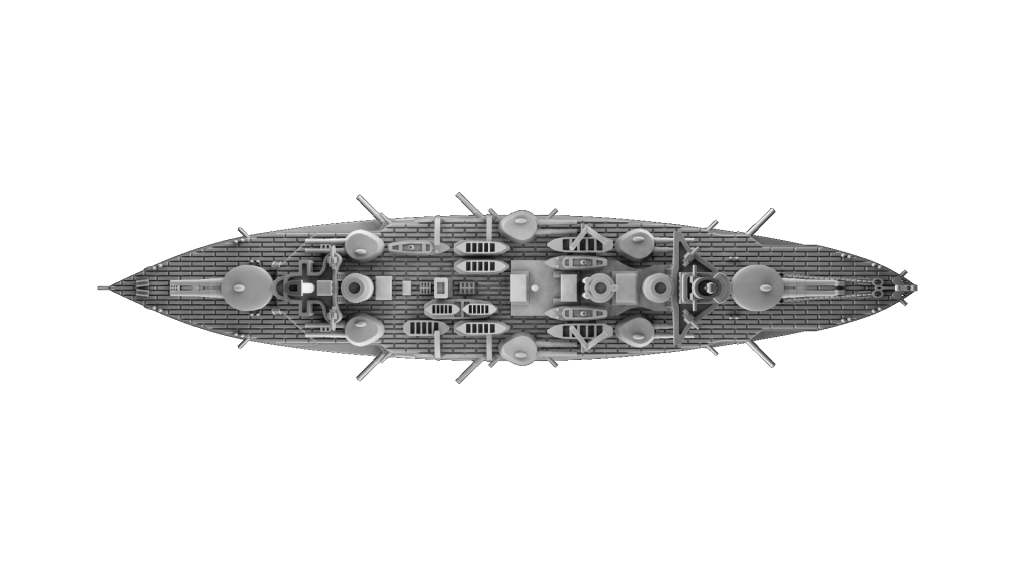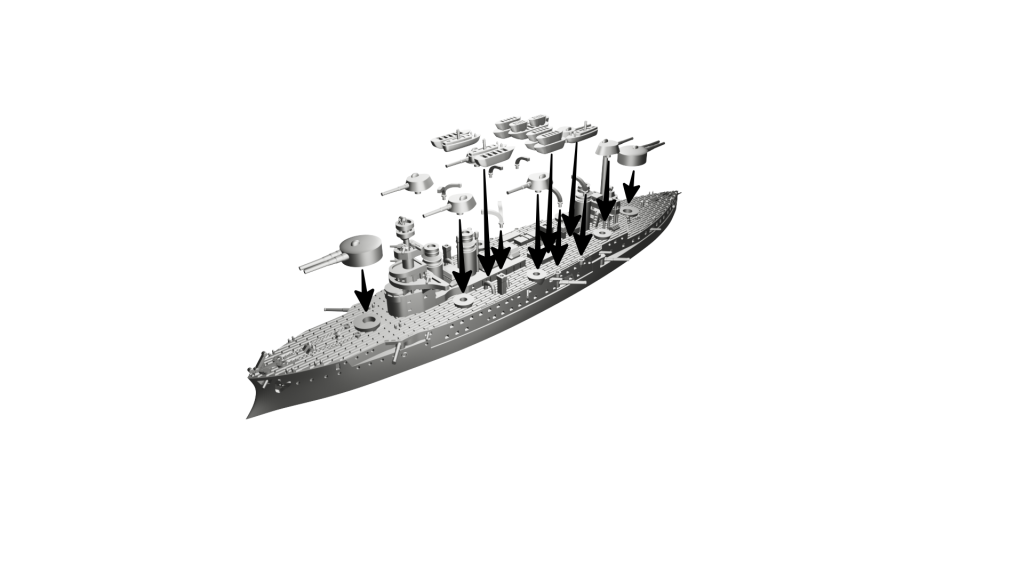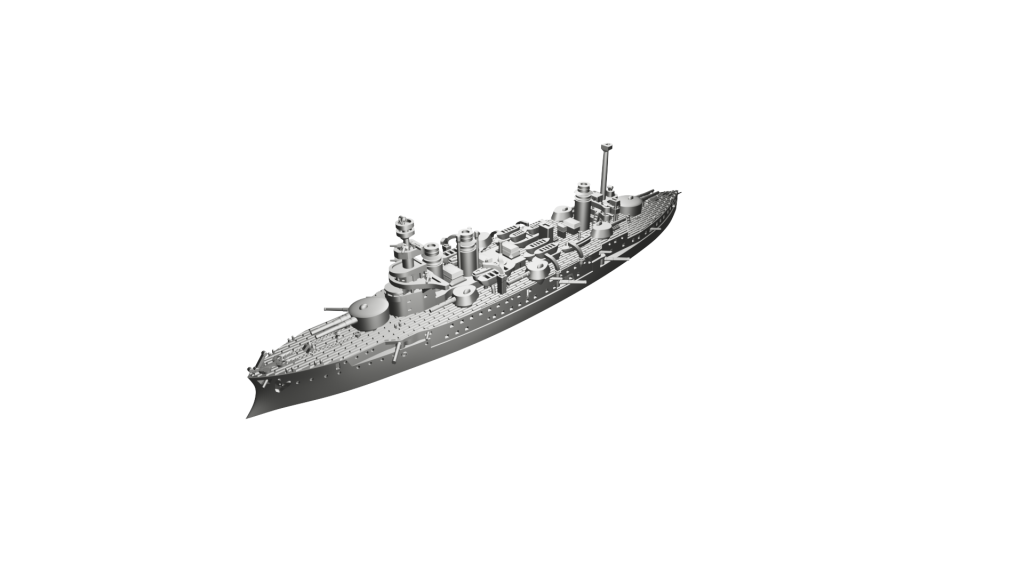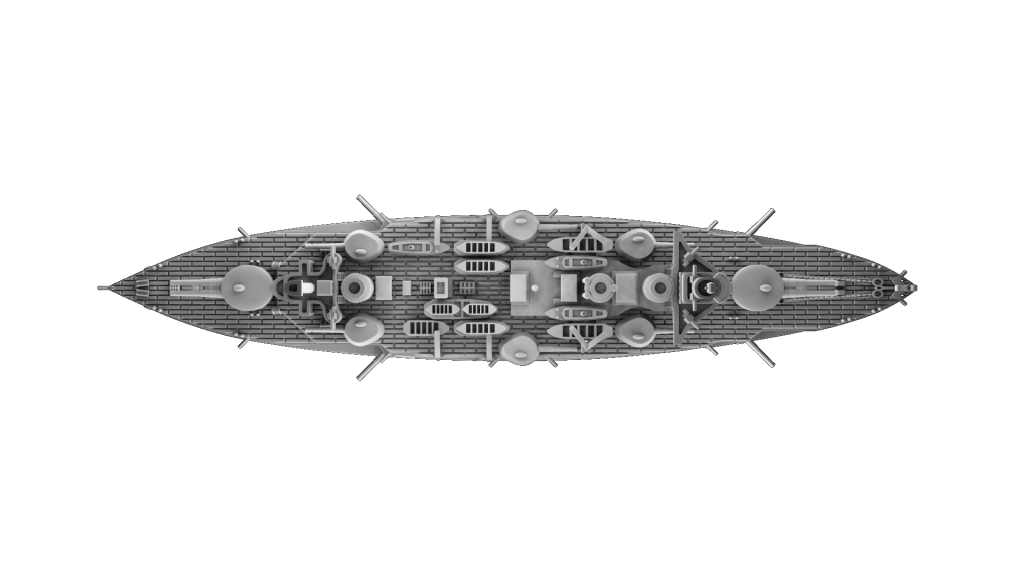General information
The painting instructions for French ships can be found here: LINK.
This page contains only basic information about the models and ships, along with the painting scheme that should be applied (the instructions on the linked page show what the specific scheme looks like).
At the turn of the 19th and 20th centuries, the French Navy underwent a period of major transformation. This was not only about technological change and the race for increasingly modern vessels – a challenge faced by most great maritime powers – but also about deep doctrinal shifts that defined the fleet’s missions and, consequently, determined which types of ships needed to be built.
The main influence was the so-called Jeune École (Young School), which began to dominate French naval doctrine after the defeat in the war with Prussia in 1870–1871. It assumed that the battleship would decline in importance, to be replaced by swarms of torpedo boats. Supporting these small torpedo craft were to be cruisers, one of whose main tasks would be to attack enemy shipping on sea trade routes.
As a result (and also due to budgetary constraints), French battleships built in the 1880s and 1890s and even at the turn of the century had limited displacement. This meant that their designers had to meet many challenges in order to provide adequate protection, firepower, and speed within those limits. That is why many French ships of this period acquired the very characteristic tumblehome hull shape.
At the beginning of the 20th century, the Young School concept was finally abandoned, but its influence – including the neglect that resulted from its application – remained visible for a long time.
Therefore, the French fleet available to players will be highly diverse. It will include the newest battleships, comparable to the best British ones, as well as older vessels of much smaller displacement. The armoured cruisers will generally be very large, while the smaller ones will be relatively slow. There will also be a wide range of torpedo craft of varying quality and interesting characteristics.
In general, these ships will be well armed and reasonably well armoured, although often – especially in the case of battleships – smaller than their opponents.
Yet they will undoubtedly be the most beautiful models on the gaming table!
Vive la France!
6th Era – predrednoughts
GMT-FRA-002 Suffren battleship
Class: 1
Base length: 14 cm.
Each set includes bases for the models.
Colour scheme: French (hull in black; superstructures, funnels, and masts in Toile Mouillée, corresponding to Vallejo 72.098 Elfic Flesh or Vallejo 70.819 Iraqi Sand. Decks in Vallejo 72.032 Bone White or a lighter shade, e.g. AK 11114 Deck Tan). Boats in white (sides), with the tops of the boats in wood colour.
Models in a set: 1.
Models on one base: 1.
Cards in a set: 1.
Each card comes with a protective sleeve.
Suffren was a French pre-dreadnought battleship, commissioned in 1904. The ship displaced around 12,500 tons and could steam at 17 knots. While the Charlemagne-class battleships were still under construction, the French Minister of the Navy began pushing for more ships. This resulted in the construction of the Suffren battleship. The main armament consisted of four 305 mm guns in two twin turrets, along with ten 164.7 mm guns, eight 100 mm guns, and numerous 47 mm quick-firing guns. One of the more unusual events of her career was an armour plate test conducted on one of her turrets. Inside the turret, a flock of sheep was placed. The battleship Massena, anchored just 100 metres away, fired several rounds at the plate. Although cracks appeared, the armour withstood the hits, and the sheep survived unharmed. One fragment from a shell even flew just a few metres past the French Minister of the Navy observing the test! Suffren took part in the First World War, including the Dardanelles campaign and was sunk in 1916 by a submarine. In the game, Suffren will be a very valuable battleship. Well-armoured, heavily armed (18 different medium-calibre guns!), and only slightly slower than most other battleships in the game. And as is often the case with French ships, she is also a beautiful vessel.
GMT-FRA-003 Massena battleship
Class: 1
Base length: 12 cm.
Each set includes bases for the models.
Colour scheme: French (hull in black; superstructures, funnels, and masts in Toile Mouillée, corresponding to Vallejo 72.098 Elfic Flesh or Vallejo 70.819 Iraqi Sand. Decks in Vallejo 72.032 Bone White or a lighter shade, e.g. AK 11114 Deck Tan). Boats in white (sides), with the tops of the boats in wood colour.
Models in a set: 1.
Models on one base: 1.
Cards in a set: 1.
Each card comes with a protective sleeve.
Masséna, named in honour of Marshal of France André Masséna, was a battleship of the French Navy, built by Ateliers et Chantiers de la Loire shipyard and commissioned in 1898. She was a member of a group of five broadly similar battleships, along with Charles Martel, Jauréguiberry, Bouvet, and Carnot, that were ordered in response to the British Royal Sovereign class. Masséna displaced 11,735 tons and measured 112 metres in length. Her main battery consisted of two 305 mm (12 in) guns, and two 274 mm (10,8 in) guns in two single-gun turrets, one amidships on each side. Her secondary armament consisted of eight 138,6 mm guns, eight 100 mm (3.9 in) quick-firing guns, and twenty small calibre guns. In 1900, Masséna took part in very important manoeuvres, during which part of the French fleet simulated a blockade of Brest, followed by an attack on Cherbourg. In 1903, Masséna was transferred to the Mediterranean Squadron and placed in reserve. She was temporarily reactivated for the period of the great fleet manoeuvres. The ageing battleship was scuttled at the end of 1915 as a breakwater during the evacuation of the Entente forces from Gallipoli. Although Masséna’s parameters differ from those of the most modern battleships, her powerful armament will be a threat to any vessel in the game.
GMT-FRA-004 Jeanne D`Arc armoured cruiser
Class: 2
Base length: 14 cm.
Each set includes bases for the models.
Colour scheme: French (hull in black; superstructures, funnels, and masts in Toile Mouillée, corresponding to Vallejo 72.098 Elfic Flesh or Vallejo 70.819 Iraqi Sand. Decks in Vallejo 72.032 Bone White or a lighter shade, e.g. AK 11114 Deck Tan). Boats in white (sides), with the tops of the boats in wood colour.
Models in a set: 1.
Models on one base: 1.
Cards in a set: 1.
Each card comes with a protective sleeve.
Jeanne d’Arc was a French armoured cruiser, commissioned in 1903. The ship displaced around 11,300 tons and could reach about 21 knots. It was designed for long-range operations, with quite good armour protection, having a 150 mm belt. Her main armament consisted of two 194 mm guns, along with fourteen 138,6 mm guns. Additionally, the ship had several 47 mm quick-firing guns and two 450 mm torpedo tubes. She served primarily with the Northern Squadron and later in the Mediterranean, participating in fleet manoeuvres designed to test French naval strategy and the coordination of armoured cruisers with battleships. The cruiser undertook several long-distance training cruises, visiting ports in North Africa, the Caribbean, and South America, showcasing French presence abroad. In 1905, she played a key role in diplomatic visits to South American nations, demonstrating both naval power and technological advancement. She was decommissioned in 1928 and scrapped in 1934. In the game, Jeanne d’Arc is among the most powerful armoured cruisers. Although there are vessels in this class with stronger armour, heavier armament, or greater endurance, Jeanne d’Arc perfectly combines all three characteristics, making her an exceptionally dangerous ship for any opponent.
GMT-FRA-005 D’Entrecasteaux protected cruiser
Class: 2
Base length: 12 cm.
Each set includes bases for the models.
Colour scheme: French (hull in black; superstructures, funnels, and masts in Toile Mouillée, corresponding to Vallejo 72.098 Elfic Flesh or Vallejo 70.819 Iraqi Sand. Decks in Vallejo 72.032 Bone White or a lighter shade, e.g. AK 11114 Deck Tan). Boats in white (sides), with the tops of the boats in wood colour. Optional colonial French scheme – in this case, the hull in white, with the rest unchanged.
Models in a set: 1.
Models on one base: 1.
Cards in a set: 1.
Each card comes with a protective sleeve.
In the mid-1890s two concepts of fleet development clashed within the French Navy. One – more traditional – supported the construction of small reconnaissance cruisers and large armoured cruisers. The other – associated with the Jeune École (Young School) – called for the creation of large, fast, armoured protected cruisers intended to serve as raiders or flotilla leaders in the colonies. The construction of D’Entrecasteaux was the result of the temporary dominance of the latter concept.
The ship was built by the Société Nouvelle des Forges et Chantiers de la Méditerranée and entered service in 1899 (five years after being launched). Her displacement was nearly 8,000 tons and her maximum speed was about 19 knots.
Her armament consisted of two 240 mm guns (no other French cruiser of that era carried such large guns), twelve 138 mm guns, twelve 47 mm guns, six 37 mm guns, and four torpedo tubes.
After entering service, she became the flagship of the French fleet stationed in Indochina. She took part in the suppression of the Boxer Rebellion and later served during the First World War. After the war, in 1927, she was sold to Poland, where she was first renamed the training hulk ORP Król Władysław IV, and later ORP Bałtyk. She remains the largest ship in the history of the Polish Navy.
GMT-FRA-006 Friant protected cruiser
Class: 3
Base length: 10 cm.
Each set includes bases for the models.
Colour scheme: French (hull in black; superstructures, funnels, and masts in Toile Mouillée, corresponding to Vallejo 72.098 Elfic Flesh or Vallejo 70.819 Iraqi Sand. Decks in Vallejo 72.032 Bone White or a lighter shade, e.g. AK 11114 Deck Tan). Boats in white (sides), with the tops of the boats in wood colour. Optional colonial French scheme – in this case, the hull in white, with the rest unchanged.
Models in a set: 1.
Models on one base: 1.
Cards in a set: 1.
Each card comes with a protective sleeve.
Three Friant-class cruisers were built in the first half of the 1890s. The naval manoeuvres conducted at that time clearly showed that France lacked modern cruisers that could serve as fleet scouts. This led to the development of the Friant-class cruisers. These units displaced just over 3,700 tons, measured just under 100 meters in length, and could reach a speed of about 18 knots, which was a decent value for the mid-1890s, though not groundbreaking. Their armament consisted of 6×164 mm guns, 4×100 mm guns, 8×47 mm guns, 3×37 mm guns, and two torpedo tubes. The three ships of this class were divided between the Northern Squadron and the Mediterranean Fleet, but in 1900, all three were sent to China to participate in suppressing the Boxer Rebellion. Two of these ships took part in World War I, albeit in a support role. These ships have a beautiful, classic French silhouette, with a characteristic strong tumblehome hull and a very prominent ram. Despite their relatively modest speed for their class, they were useful in fulfilling many auxiliary roles, including combat against destroyers, gunboats, controlling buoys, zones, and port bombardment. The six 164 mm guns made them a threat to any ship within their combat range.
GMT-FRA-007 D`Iberville-class torpedo gunboat
Class: 4
Base length: 10 cm.
Each set includes bases for the models.
Colour scheme: French (hull in black; superstructures, funnels, and masts in Toile Mouillée, corresponding to Vallejo 72.098 Elfic Flesh or Vallejo 70.819 Iraqi Sand. Decks in Vallejo 72.032 Bone White or a lighter shade, e.g. AK 11114 Deck Tan). Boats in white (sides), with the tops of the boats in wood colour. Optional colonial French scheme – in this case, the hull in white, with the rest unchanged.
Models in a set: 2.
Models on one base: 1.
Cards in a set: 2.
Each card comes with a protective sleeve.
The D’Iberville-class torpedo cruisers were built in the first half of the 1890s. The first vessel of the series was named in honour of the explorer Pierre Le Moyne d’Iberville. They displaced around 950 tons and measured 80 metres in length. Designed for speed and agility, they were powered by triple-expansion steam engines enabling a top speed of 21 knots, making them one of the fastest vessels of the French Navy at the time. Her armament as a lead ship of the class consisted of one 100 mm (3.9 in) guns, three 65 (3 pounder) guns, seven 47 mm (1.9 in) guns, and six 450 mm (17,7 in) torpedo tubes. This combination allowed D’Iberville to engage both enemy large vessels and torpedo boats, while her speed enabled rapid reconnaissance and raiding missions. D’Iberville’s service was largely in the Mediterranean and along the French Atlantic coast. She participated in numerous naval exercises and maneuvers, helping refine tactics for torpedo cruisers. Her design and performance influenced subsequent classes of French light ships. In the game, D’Iberville represents a fast, lightly armoured vessel capable of devastating torpedo attacks, and protecting larger ships from small, aggressive enemy vessels.
GMT-FRA-008 Framée-class destroyer
Class: 4
Base length: 8 cm.
Each set includes bases for the models.
Colour scheme: French (hull in black; superstructures, funnels, and masts in Toile Mouillée, corresponding to Vallejo 72.098 Elfic Flesh or Vallejo 70.819 Iraqi Sand. Decks in Vallejo 72.032 Bone White or a lighter shade, e.g. AK 11114 Deck Tan). Boats in white (sides), with the tops of the boats in wood colour. OR overall grey (Vallejo Dark Sea Grey 70.991
Models in a set: 4.
Models on one base: 2.
Cards in a set: 2.
Each card comes with a protective sleeve.
The Framée class comprised four early French destroyers completed in 1900-1901. Each ship was about 58 meters long and displaced 319 tons, reaching a speed of 26 knots. The armament consisted of one 65 mm gun, six 47 mm guns, and two 381 mm torpedo tubes. These destroyers primarily served in anti-torpedo boat duties and were deployed during the early years of the French destroyer programme. Framée itself sank in 1900 after a collision with the battleship Brennus, with heavy loss of life. The remaining sister ships operated during World War I but were either lost or scrapped shortly after the war. In the game, the Framée-class destroyers will be extremely useful vessels. Their strong torpedo armament will pose a threat even to the largest ships, while their smaller calibre guns will easily deal with enemy torpedo boats. Although they are not among the fastest destroyers, their speed is more than sufficient to carry out the tasks assigned to them.
GMT-FRA-009 Mistral-class torpedo boat
Class: 4
Base length: 6 cm.
Each set includes bases for the models.
Colour scheme: French (hull in black; superstructures, funnels, and masts in Toile Mouillée, corresponding to Vallejo 72.098 Elfic Flesh or Vallejo 70.819 Iraqi Sand. Decks in Vallejo 72.032 Bone White or a lighter shade, e.g. AK 11114 Deck Tan). Boats in white (sides), with the tops of the boats in wood colour. OR overall grey (Vallejo Dark Sea Grey 70.991
Models in a set: 4.
Models on one base: 2.
Cards in a set: 1.
Each card comes with a protective sleeve.
The Mistral-class consisted of six French torpedo boats, all launched in 1901 and built at the Normand, Graville, and Loire shipyards. Based on the earlier Cyclone design, these vessels were the first French torpedo boats to feature proper splinter armour. A 25 mm thick nickel-steel armoured box protected their engine rooms, while a 9 mm deck offered additional protection. The added armour increased their displacement by 18 tons, slightly reducing speed (to 26 kts). Mistral-class torpedo boats measured 47 metres in length with a beam of 5.15 metres and a draught of 1.6 metres. They displaced 113 tons standard, with a crew of 30. Their armament included two 15-inch torpedo tubes and two 47 mm QF guns, making them capable of both offensive torpedo strikes and self-defence against smaller vessels. All six vessels served actively during World War I, performing coastal patrols, escort duties, and fast attack missions. They were decommissioned and broken up between 1924 and 1928. Small, fast, good armoured and well armed with torpedoes – the Mistral class is an excellent choice for those who like to conduct many torpedo strikes.
GMT-FRA-010 République-class battleship
Class: 1
Base length: 14 cm.
Each set includes bases for the models.
Colour scheme: French (hull in black; superstructures, funnels, and masts in Toile Mouillée, corresponding to Vallejo 72.098 Elfic Flesh or Vallejo 70.819 Iraqi Sand. Decks in Vallejo 72.032 Bone White or a lighter shade, e.g. AK 11114 Deck Tan). Boats in white (sides), with the tops of the boats in wood colour.
Models in a set: 1.
Models on one base: 1.
Cards in a set: 1 (Republique & Liberté).
Each card comes with a protective sleeve.
The République-class consisted of two pre-dreadnought battleships built for the French Navy in the early 1900s. Their construction was a clear signal of France’s departure from the Jeune École concept and from building small battleships displacing no more than 12,000 tons. République and Patrie displaced 14,870 tons and measured 135 metres long, with a beam of 24.25 metres and a draught of 8.2 metres. Powered by three triple-expansion steam engines and 24 Niclausse boilers, they could reach 19 knots and carried a crew of around 750. Their main armament included four 305 mm (12 in) guns in two twin turrets, supported by eighteen 164 mm (6.5 in) guns, twelve 65 mm (2,6 in) guns, and six 47 mm guns for close defence. Armour protection reached 280 mm on the belt and 360 mm on turrets. After their launch, they became the most powerful French battleships. Already during construction, it was noticed that other navies were introducing a higher calibre of secondary artillery, but the work on the first two vessels was too far advanced; therefore, heavier guns were only introduced with the Liberté class. République-class ships are powerful pre-dreadnoughts with strong armament and very good armour, able to withstand heavy fire while commanding the battle line.
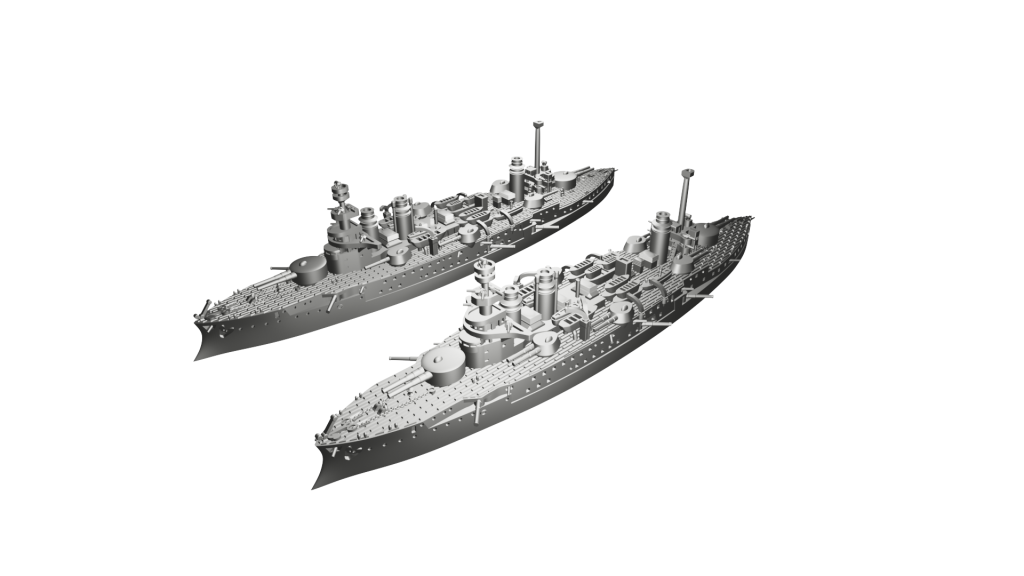
For those who wish to stay very faithful to history and reproduce Liberté as accurately as possible, the barrels of the guns in the middle casemate (on both sides) should be cut off, leaving only those closer to the stern and the bow. The opening should then be filled with Green Stuff. This is, however, only an option and a suggestion for those who prefer Liberté to République.

